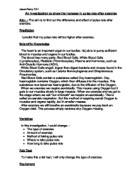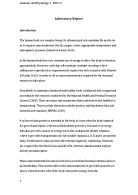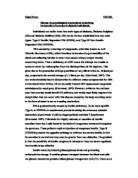Sample Volume 20μL
Sample Capacity Single Sample
Readout 2-line digital display
Units mOsm/kg H2O
Range 0 to 2000 mOsm/kg H2O
Linearity less than 1% from straight line
Resolution 1 mOsm/kg H2O
Repeatability ±2 mOsm/kg H2O (1 S.D.)
between 0 & 400 mOsm/kg H2O;
±0.5% (1 S.D.) between 400 & 2000
mOsm/kg H2O
Storage Temperature -40 to +160oF or
-40 to +70oC
Operating Temp (ambient) 64 to 95oF or
18 to 35oC
Drift < 1 digit per month + 1 digit for
every 9oF or 5oC ambient temperature
change.
Room Humidity 5 80% (non-condensing)
Start-up Time 30 seconds from power on
Test Time 60 seconds per sample
Dimensions W - 27cm, D - 35cm, H - 38cm
Weight 6.4kg
2. Materials and Methods
The laboratory protocol was followed exactly. Please see appendix A.
3. Results
All testing was completed under conditions that were as carefully controlled as possible. The laboratory was not controlled with regard to temperature, although it remained constant through the experiment at 24 0 C. It was noted after ten minutes that there was incorrect use of the tympanic thermometer by subject (B).
Figure 1.1 and 1.2 shows that in subjects (A) and (B) as production of (ETC02) rises, the respiratory centre is stimulated and therefore increases the respiratory rate to expel the excess (C02) and so maintaining a homeostatic state. After this sudden increase in ventilation, a brief pause is noticed prior to a further increase to steady state exercise.
It also can be seen that as sub-maximal exercise is stopped there is an abrupt decrease in respiration followed by a gradual increase to normal resting values. The overall trend appears to support the above and is shown in the raw data collected from the cohort.
Figure 1.1
Figure 1.2
In Figure’s 2.1 and 2.2 it becomes apparent that as (HR) increases due to the sub- maximal exercise performed in a healthy individual, there is an increase in Work Rate (WR). It is an initial steep rise in both (HR) and (WR) for both subjects. In subject (A),a steady state is achieved after four minutes whereas this is not achieved until eight minutes in subject (B). This could be due to a difference in individual fitness levels.
Figure 2.1
Figure 2.2
(WR) = energy used during exercise
(WR) has been calculated using the following equation;
Work rate (WR) = Body Mass x 9.8 x step height x number of steps per second.
Key: Gravity = 9.8 ms2
Step Height = 0.183 m.
Work Rate = Watts
In Figure 3.2 heat production rises dramatically on commencing exercise, then drops suddenly between eight and twelve minutes, whereas in figure 3.1, there is a sudden drop in temperature on commencing exercise .
Figure 3.1
Figure 3.2
4. Discussion
In our investigation of the cardiovascular and respiratory responses to sub-maximal exercise under controlled conditions, it was hypothesized that during exercise there will be an increase in (ETCO2) production.
“An increase in the (C02) concentration in body fluids increases Hydrogen ions (H+) and thus lowers the pH (makes body fluids more acidic)”(Tortora & Grabowski 2003)
As skeletal muscles contract during exercise there is an increase in (02) consumption and an increase in (C02) production. During aerobic metabolism, glucose and fats utilize oxygen to form (ATP), the ultimate source of energy. There is very little (02) stored in the body, so aerobic metabolism requires continuous delivery of (02) from the atmosphere to the blood. “The (C02) is a waste product of aerobic cellular metabolism, and is transported by the blood in three ways 1) 9% is dissolved in plasma, 2) 13% bound to hemoglobin (carboaminohemoglobin) 3) 78% transported as bicarbonate ions” (Tortora & Grabowski 2003). When (C02) enters the red blood cells via diffusion a reaction occurs with water and the enzyme carbonic anhydrase (CA) resulting in carbonic acid (H2CO3) which then disassociates into (H+) and Hydrogen Bicarbonate (HC03-) as shown in the following equation.
C02 + H20 H2C03 (H+) + HC03-
Carbon Water Carbonic Hydrogen Bicarbonate
Dioxide Acid Ion Ion
This increase of (C02) is detected by central chemoreceptors located in the medulla oblongata and in the carotid and aortic bodies. Central chemoreceptors respond to changes in (H+) concentration and Partial Pressure (Pa C02) in the cerebrospinal fluid, as do the peripheral chemoreceptors which respond to the same changes in the blood. These groups of neurons take part in a negative feedback system that control the levels of (C02) (H+) and (02) in the blood, causing the diaphragm and other respiratory muscles to contract with greater frequency and more strength. Therefore an increase of (C02) on exercise is detected, the respiratory centre is stimulated and the rate and depth of ventilation is increased to expel (C02). As noticed through the cohort, on exercise the production of (C02) is increased in a linear fashion suggesting muscles need a huge amount of oxygen during exercise and thus their cells produce a greater amount of (C02).
(Robergs et al 2000) states “during exercise the contracting skeletal muscles contribute more than 90% of the increased demand for oxygen consumption”. to achieve this must be an instant rise in cardiac output (CO) at the start of exercise. “The cardiac output is determined by multiplying (HR) per minute with the stroke volume (SV) the amount of blood ejected by the left ventricle with each contraction”. (Vander et al 2001) CO = HR x SV.
The cardiovascular response to this increase in (WR) is to increase (HR) and (SV). These changes are brought about by autonomic regulation of the heart which is derived in the cardiovascular centre of the medulla. From here sympathetic and parasympathetic impulses are increased or decreased according to need. Prior to starting the experiment it is seen in subject (B) a rise in (HR). This anticipatory increase is due to the limbic system being stimulated which in turn sends cortical impulses to the medulla oblongata resulting in an increase in (HR).
“Heart rate can also be influenced by certain hormones and cations, exercise, stress and excitement cause the adrenal medullae to release hormones”. (Tortora & Grabowski 2003). Epinephrine and norepinephrine, which are produced in the adrenal medullae increase contractility and (HR), whereas differences in the concentrations of mainly three cations have a considerable effect on (HR). Raised levels of Potassium (K+) or Sodium (Na+) cause a reduction of heart rate and contractility. Increased (Na+) impedes Calcium (Ca2+) flow on contraction of the cardiac muscle, therefore decreasing the force of contraction as opposed to raised (K+), which stops the production of action potentials.
(Margaria et al) suggests “a ‘fit’ subject has a lower (HR) at any step rate, and smaller changes in (HR) from one work rate to the next, compared to an unfit subject”. This is displayed in figure’s 2.1 and 2.2 as subject (A)’s (HR) is approximately 20 bpm lower throughout the test. Subject (A) later stated he ran everyday and subject (B) admitted he did no form of physical exercise. Subject (B)’s, (HR) dropped to 22 bpm after 16 minutes of exercise. This could be explained by the subject being distracted by others members of the cohort, resulting in incorrect placement of the pulse oximeter probe.
Metabolic heat generated during exercise is transferred to the environment from the skin surface via conduction, convection, and radiation of dry heat and evaporative heat transfer pathways. Parameters within the environment that influence heat exchange include the, ambient temperature, which was 240 C ,on the day, water vapour pressure, radiant heat, air movement and the properties of clothing.
As hypothesized “heat is transferred from the contracting muscles to the body core during the first minutes of exercise, body core temperature rises and the hypothalamic thermoreceptors increase their activity in response to the increased local temperature” (Mack G.W et al 2000) .This statement is confirmed by subject (B) whereas in subject (A) there is an immediate drop in temperature of 1.5 0C on commencing exercise. This was due to incorrect use of the tympanic thermometer which was quickly rectified.
5. Conclusion
This study found that as there is an increase in the production of (ETC02) and a minimal rise in body temperature as a result of increased cellular production induced by exercise. There is an increase in (HR) and alveolar ventilation maintaining a homeostatic state, thus confirming that cardiovascular and respiratory mechanisms must work in a combined fashion to support the (02) needs of exercising tissue, and to eliminate from the body the waste products that are brought about by increased cellular metabolism, namely heat and (C02) ,thus maintaining homeostasis.
6. Reference
1. Shepard R.J. & Astrand P.O (2000) Endurance in Sport. In .Wetter. T.J and Dempsey P.A (eds) Pulmonary System and Endurance Exercise. London. Blackwell Science. 52
2. Tortora and Grabowski (2003) Principles of Anatomy & Physiology 10th ed.USA John Wiley & Sons (27) 1002.
3. Tortora and Grabowski (2003) Principles of Anatomy & Physiology 10th ed.USA John Wiley & Sons (23) 834
4. Robergs. R A. & Roberts S O. (2000) Exercise Physiology for Fitness, Performance and Health. USA. The McGraw Hill Companies (7) 148
5. Vander A, Sherman J, Luciano D, (2001) Human Physiology, The Mechanisms of Body Function 8th ed. USA. The McGraw Hill Companies (14) 400
6. Tortora and Grabowski (2003) Principles of Anatomy & Physiology 10th ed.USA John Wiley & Sons (20) 685.
7. Howley E T, Turner M J. Step Tests: Description and Physiology (online)
[accessed 02 April 2003] London. Blackwell Science 262.
8. Shepard R.J. & Astrand P.O (2000) Endurance in Sport. In Mack G W & Nadel E R. (Eds) Endurance in Hot and Cold Environments







